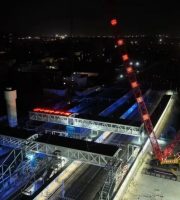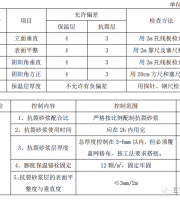05 summary: pipeline works are concealed works, and only inspection wells are available for people to inspect when they are completed.
In short, the excellence of drainage pipeline engineering must be based on the excellence of main structure engineering.
(2) If the soil at the bottom of the tank is disturbed or soaked by water, the soft soil layer shall be excavated first, and then the over excavated part shall be backfilled and compacted with stable materials such as miscellaneous sand or gravel.
(4) Control the water content of the filler to be more than about 2% of the optimum water content; In case of groundwater or rain, the construction must drain the water first, and then fill and compact in layers.
02 water leakage of pipeline, unqualified closed water test (I) causes: uneven sinking of foundation, poor construction quality of pipe and its interface, loose sealing at the end of closed water section, poor construction quality of well body, etc.
Different tamping tools shall be selected for different fillers and filling thicknesses to achieve the most economical compaction effect.
Long press the QR code to follow me..
Poor pipeline foundation conditions will lead to uneven settlement of pipeline and foundation, generally causing local ponding, and serious pipeline fracture or interface cracking.
The filler and construction quality of pipe interface are poor, and the pipeline is damaged or the interface is cracked under the action of external force.
For example, miscellaneous sand and gravel are used for pit backfilling of drainage and other facilities under the main road in Nanning.
Therefore, the construction quality of inspection well often affects the evaluation of overall engineering quality.
The practice has proved that the effect is very good.
(2) When the trench is narrow, manual or frog rammer can be used for tamping.
(4) Generally, the inspection well shall be sealed before masonry to ensure the quality.
For example, local filling can be taken on asphalt pavement to avoid ponding; (2) In case of void damage to the foundation of other structures, it can be filled with pumped cement slurry; (3) If the structure is damaged, the bad filler shall be excavated, the material with good stability shall be replaced, and the damaged structure shall be restored after compaction.
When the pipe diameter is large, the inner and outer sides shall be smaller, and only the outer side shall be pointed or plastered.
The main measures to prevent diseases caused by measurement and construction are: (1) re measurement and protection of handover piles shall be carried out carefully according to construction measurement specifications and procedures before construction.
At this time, marks shall be made at the leakage one by one, and careful treatment shall be carried out after draining the water in the main pipe.
(3) When excavating earth below the groundwater level, effective measures shall be taken to prevent drainage and precipitation at the bottom of the trench to ensure the excavation of the dry trench.
In the construction process, efforts should be made to overcome various common problems, ensure the excellent construction quality of the overall project, and then do a better job in the construction quality of the inspection well, so as to achieve the goal of excellence.
Serious leakage can be handled by professional technicians in addition to replacing pipes and refilling interfaces.
Those found or with quality problems shall be ordered to leave the site or can be used only after effective treatment.
(2) Prevention and treatment measures 1.
(2) Prevention measures 1.
These materials can not be used as filler to avoid subsidence.
(3) The silt, tree roots, turf and rotten plants in the filler not only affect the compaction effect, but also dry shrink and decay in the soil to form holes.
(2) Construction setting out shall be carried out in combination with hydrogeological conditions, in accordance with buried depth, design requirements and relevant regulations, and must be retested and inspected, and the error can be delivered for construction only after it meets the requirements; (3) The construction shall be carried out in strict accordance with the sample pile, and the axis and longitudinal slope shall be measured and accepted for the trench and flat foundation.
4.
When the geological and hydrological conditions of the foundation are poor, soil replacement and improvement shall be carried out to improve the bearing capacity at the bottom of the foundation trench.
2.
6.
Preventive measures: (1) the masonry mortar of the inspection well shall be full, and the pointing shall be comprehensive without omission; Clean and wet the surface before plastering, and press polish, collect and maintain it in time during plastering; In case of groundwater, plastering and pointing shall be completed in time with masonry, and internal plastering or pointing shall not be carried out after backfilling; (2) The external surface of the pipe connected to the inspection well shall be wet and evenly brushed with a layer of cement slurry, and the internal and external plastering shall be done after the slurry is in place to prevent leakage.
If necessary, 20cm thick soil layer can be reserved at the bottom of the trench and removed at the same time of excavation during the construction of subsequent processes.
The quality of pipes is poor, there are cracks or local concrete is loose, the impermeability is poor, and the capacity produces water leakage.
Small cracks or pitted surface leakage can be brushed with cement slurry or waterproof coating, and the more serious ones shall be reworked.
During construction, if structures must be avoided, connecting wells shall be added at appropriate positions, which shall be connected in a straight line, and the angle of connecting wells shall be greater than 135 °.
The plastering shall be constructed according to the waterproof 5-layer construction method.
If brickwork is used for blocking, the following points should be paid attention to: (1) before blocking, the inner wall of the pipe within about 0.5m of the pipe orifice should be cleaned, coated with cement slurry, and the bricks used should be wetted for standby; (2) The grade of masonry mortar shall not be lower than M7.5 and have good consistency; (3) The grade of cement mortar used for pointing and plastering shall not be lower than M15.
2.
(1) During pipe trench backfilling, appropriate fillers and compaction machines must be selected according to the backfilling position and construction conditions.
(2) Preventive measures: 1.
01 pipeline position deviation or ponding (I) causes: measurement errors, construction aliasing and accidental avoidance of original structures, resulting in position deviation on the plane, ponding or even slope on the facade.
The masonry quality of inspection well shall control the center position and height of well chamber and wellhead to prevent well body deformation.
5.
(2) Preventive measures 1.
2.
2.
Prevention and control measures: (1) select high-quality interface filler and organize the construction according to the test mix proportion and reasonable construction technology; (2) During tape plastering, the interface joint shall be clean, roughened if necessary, and then constructed carefully according to the construction operation procedures.
3.
03 inspection well deformation and sinking, poor quality of components and fittings (I) causes: inspection well deformation and sinking, poor quality of well cover and installation, too random installation of ladder in the well, affecting the appearance and use quality.
Therefore, it is required that: (1) the materials used shall be provided with qualification certificate and mechanical test report by the quality department; (2) The appearance quality of pipes requires that the surface is flat without loose exposed bone and honeycomb pitted surface; (3) Check section by section again before installation.
Preventive measures.
The planned reserved branch pipe is not tightly sealed, which is often ignored because it is in the well.
The deviation shall not be too large and the plane position shall be accurate.
The test shall be carried out after treatment and repeated until the closed water is qualified.
The pipe slot is filled from the chest to the top of the pipe 30cm, and then filled with water and vibrated to the relative density ≥ 0.7.
Treatment measures.
The position of the upper and lower steps shall be well controlled for the installation of iron climbing.
Carefully do a good job in the base course and cushion of the inspection well, and break the pipe to make a chute to prevent the well body from sinking.
3.
The preventive measures are: (1) carefully construct according to the design requirements to ensure the strength and stability of the pipeline foundation.
04 causes of backfill settlement (I) the backfill around the inspection well is not dense, the backfill is not compacted in layers as required, the compaction effect is affected by poor filler quality and poor water content control, resulting in excessive settlement after construction.
The construction quality of the inspection well is poor, and the well wall and the joint with its connecting pipe leak.
Manhole cover and seat shall be matched; The base slurry shall be full during installation; The light and heavy models and the surface and bottom are good.
Closed water test is a comprehensive inspection of pipeline construction and material quality, during which three or two unqualified phenomena are inevitable.
Corresponding measures shall be taken according to the degree of settlement damage: (1) a small amount of settlement that does not affect other structures can be treated without treatment or only surface treatment.


